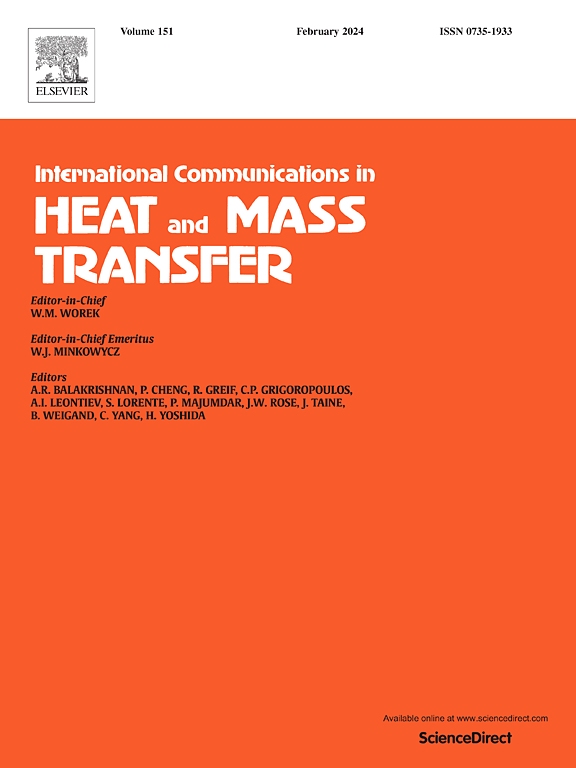Molecular dynamics of boiling heat transfer under passive liquid driven mechanism based on capillary flow in rough nanochannels
IF 6.4
2区 工程技术
Q1 MECHANICS
International Communications in Heat and Mass Transfer
Pub Date : 2025-04-01
DOI:10.1016/j.icheatmasstransfer.2025.108912
引用次数: 0
Abstract
The boiling under capillary flow greatly affects the heat transfer performance of the passive two-phase heat dissipation devices. In this study, sinusoidal structures with various amplitudes (3.615 Å, 7.23 Å and 10.845 Å) and periods (, and ) are constructed to characterize rough microchannels. The capillary flow and boiling under capillary flow in various nanochannels are investigated separately by molecular dynamics simulations. The results show that adding rough elements to wall surface reduces the maximum velocity of the liquid at least 22.9 % compared to the smooth surface. The rough elements can effectively enhance the local heat transfer efficiency and trigger the flow boiling. At the same time, the expansion of the bubble leads to the blockage and prevents the liquid supply, leading to deterioration of heat transfer. Increasing the roughness by increasing the amplitude of the sinusoidal structure will increase the heat transfer coefficient but decrease the total heat absorption. A better approach is to increase roughness by decreasing the period of sinusoidal structure, which has a favorable effect on both heat transfer coefficient and total heat absorption. The rough surface leads to an increase in the concentration of liquid atoms near the wall, enhancing the effectiveness of heat transfer.
基于粗糙纳米通道中毛细流动的被动液体驱动沸腾传热分子动力学
毛细管流动下的沸腾对被动两相散热装置的传热性能影响很大。在本研究中,构建了具有不同振幅(3.615 Å, 7.23 Å和10.845 Å)和周期(15×624Å, 215×624Å和110×624Å)的正弦结构来表征粗糙微通道。通过分子动力学模拟,分别研究了不同纳米通道中毛细管流动和毛细管流动下的沸腾现象。结果表明,与光滑壁面相比,在壁面添加粗糙元素可使液体的最大速度降低至少22.9%。粗化元件能有效提高局部换热效率,引发流动沸腾。同时,气泡的膨胀导致堵塞,阻止液体供应,导致传热恶化。通过增加正弦结构的振幅来增加粗糙度会增加换热系数,但会减少总吸热。较好的方法是通过减小正弦结构的周期来增加粗糙度,这对换热系数和总吸热都有良好的影响。粗糙的表面导致壁面附近液体原子浓度的增加,增强了传热的有效性。
本文章由计算机程序翻译,如有差异,请以英文原文为准。
求助全文
约1分钟内获得全文
求助全文
来源期刊
CiteScore
11.00
自引率
10.00%
发文量
648
审稿时长
32 days
期刊介绍:
International Communications in Heat and Mass Transfer serves as a world forum for the rapid dissemination of new ideas, new measurement techniques, preliminary findings of ongoing investigations, discussions, and criticisms in the field of heat and mass transfer. Two types of manuscript will be considered for publication: communications (short reports of new work or discussions of work which has already been published) and summaries (abstracts of reports, theses or manuscripts which are too long for publication in full). Together with its companion publication, International Journal of Heat and Mass Transfer, with which it shares the same Board of Editors, this journal is read by research workers and engineers throughout the world.

 求助内容:
求助内容: 应助结果提醒方式:
应助结果提醒方式:


